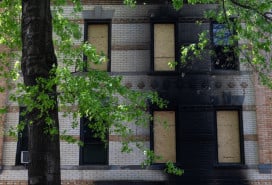‘Buyer beware’ offset by new ‘seller reveal’ requirement for townhouse deals in New York
- Property condition disclosure statements are now mandatory for most townhouse sellers
- Sellers can no longer provide a $500 credit to buyers in lieu of filling out the form

Townhouse sellers need to answer 56 questions, including the year the property was built, last service dates for mechanical systems, and the age of the roof.
iStock
New York townhouse buyers gained a new window on property conditions thanks to a regulatory change last year that makes filling out the New York property condition disclosure statement (PCDS) mandatory for sellers of existing one- to four-family properties.
The PCDS does not apply to condos or co-ops, or townhouses being sold through an estate, where presumably the heirs cannot supply this information.
As of March 2024, a seller can no longer provide a $500 credit to a buyer in lieu of filling out a PCDS, which has been an option for the past 20 years. They must fill out the form in full, and that means answering 56 questions, including the year the property was built, last service dates for mechanical systems, and the age of the roof.
There are also questions about a history of flooding, pest infestations, and fire or smoke damage. For most of these questions, answers are a choice of yes, no, unknown, or not applicable.
New responsibilities for townhouse sellers
The change has created several new conversation topics and challenges that weren't previously part of the typical transaction process, according to Steven Tanen, a townhouse expert and attorney at Starr Associates.
Sellers are required to fill out the form to the best of their knowledge, and it must be attached to the contract of sale. However, a seller who knowingly fails to provide information to a buyer can be liable for actual damages suffered by the buyer. In response, contracts are also being drafted and negotiated differently.
Seller's attorneys are including strict language in contracts to protect clients to avoid liability, regardless of how well their client knows the property, Tanen said. Some attorneys will bar or limit a buyer's right to sue under the act, for example, shorten the amount of time a buyer can file against a seller, he said.
“There’s no uniformity to this new language," he said. "Each attorney has their own way of disclosing the amendment to the property condition disclosure act and [way] to limit their client's liability from a misstatement. Some are going as far as including language that states a buyer is buying 'as-is' when that may not be the case," he added.
The importance of inspection reports
However, Tanen and other attorneys said buyers should not rely exclusively on the information in a PCDS.
“Inspections are going to tell a buyer everything they need to know about the property they intend to buy, including the age of the more expensive parts [and] systems of the home,” he said.
He said a buyer should pay attention to discrepancies between the inspection report and a seller's answers on the PCDS. One example could be the maintenance of the heating and cooling system. If a seller notes on the PCDS that they had the system recently serviced, but the inspection report indicates that it requires service, it can lead to a credit to have the system serviced or the seller agreeing to service the system prior to closing.
Buyers also need to be aware that lenders may want to see the disclosure form. If you’re getting a loan, your attorney needs to help you understand how this may impact your financing, he said.
More work for townhouse sellers
Attorney Caryn Ettinger-O’Brien, counsel in the real estate practice at Tannenbaum Helpern, said she hasn’t seen any litigation yet involving an updated PCDS. “We have not come across anyone suing yet. It’s too new,” said Ettinger-O’Brien, who published a breakdown of what buyers and sellers need to know about changes to the PCDS.
A seller or a broker representing a seller needs to be aware of the new responsibilities, because the form takes time to fill out.
“A seller can only answer the PCDS to the best of their knowledge,” Ettinger-O’Brien said. “Some may have lived there for 25 years and know everything. Others may be selling an investment property,” and not know the details. What’s more: “A seller does not have an obligation to do an inspection to address this statement,” she added.
“But if you had a leak, and hired someone to fix that leak, you can’t answer ‘you don’t know’ in response to questions about leaks,” she said.
Extreme weather and property damage
The change to the form was prompted by the increasingly frequent and extreme weather New York saw with Hurricane Ida and other events
“Many properties suffered damage or mold,” Ettinger-O’Brien said. Governor Hochul’s message was in essence: “you can’t dodge these questions for $500” any longer. The form “forces sellers to disclose whether there is mold in the basement,” she added. It provides an “extra layer of information for buyers to process.”
Still, there are always going to be blind spots. Maybe a seller doesn’t have all the information or their seller provided a $500 credit in lieu of filling out the form. And inspections don’t always turn everything up. Sometimes they indicate further inspection is needed and buyers may not be willing to pay for it.
Chipping away at ‘buyer beware’
A “buyer beware” doctrine used to be predominant in New York State. It shifted when the Property Condition Disclosure Act was originally signed into law in November 2001 by Governor George Pataki.
The act required sellers of one- to four-family properties to provide a 48-question PCDS to prospective purchasers outlining a property’s defects. However, sellers could opt to give a $500 credit to buyers instead of filling out the form.
Bottom line
Tanen said the change creates more transparency. “You get a bigger picture of what you’re buying—it’s a pretty detailed form. It’s good to understand what the seller thinks about what they’re selling in addition to the inspection.”
You Might Also Like































